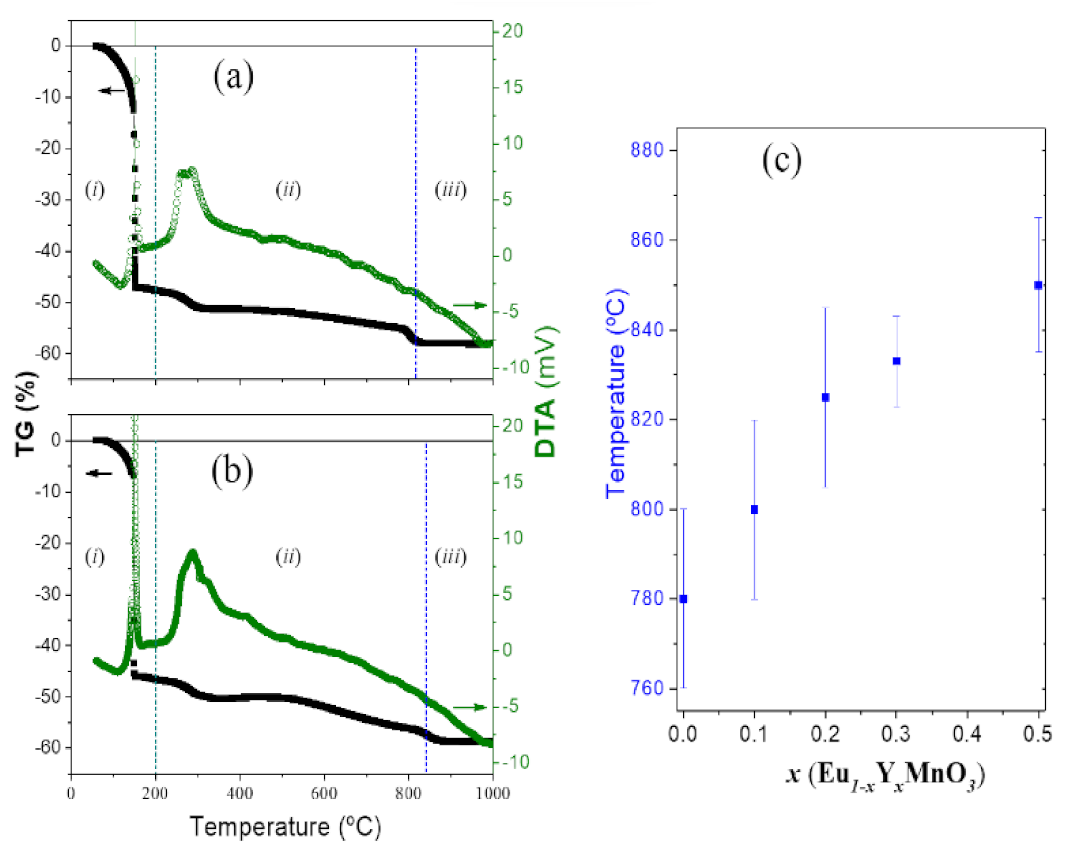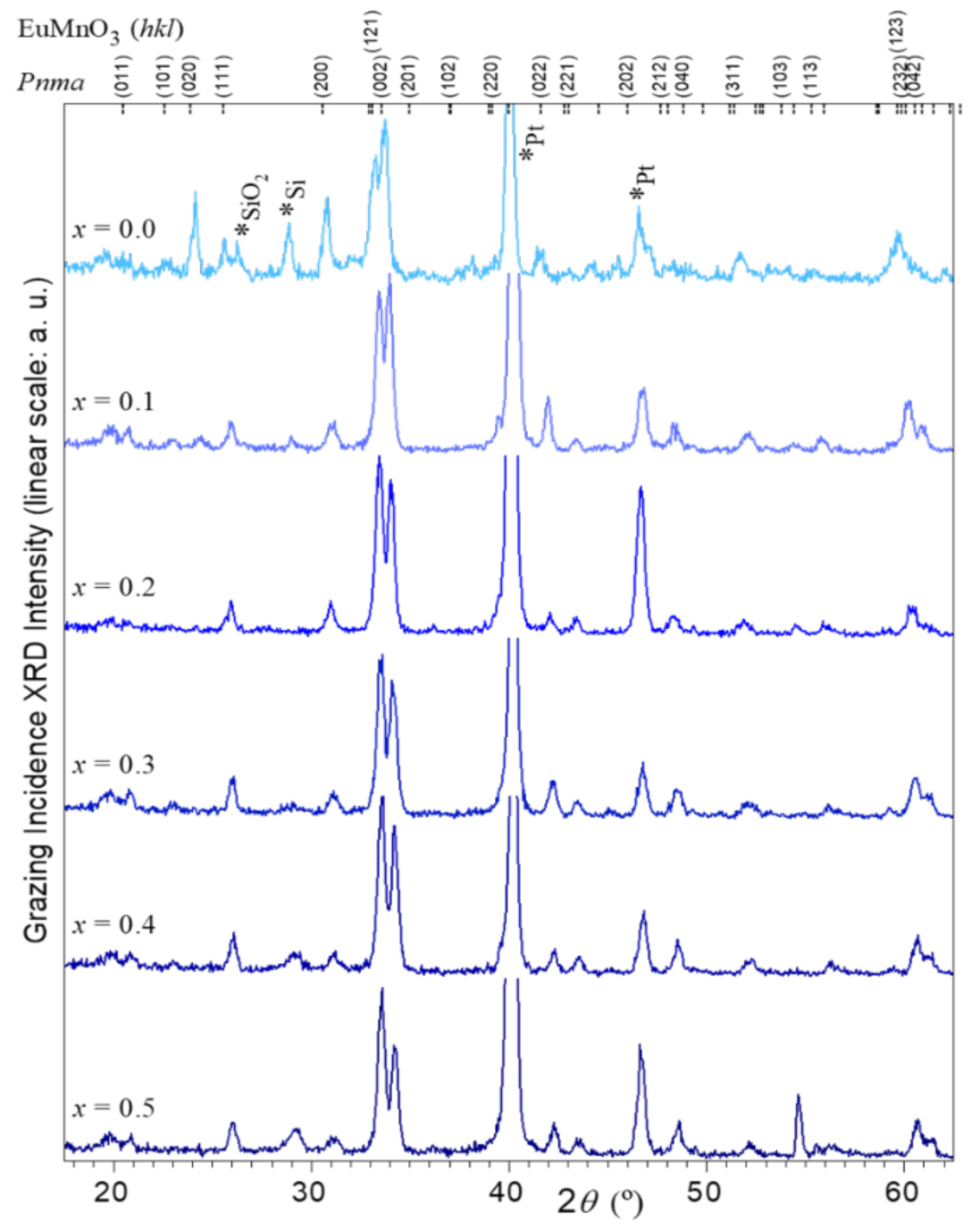Effects of Substitution and Substrate Strain on the Structure and Properties of Orthorhombic Eu1−xYxMnO3 (0 ≤ x ≤ 0.5) Thin Films
Abstract
Highlights
- Orthorhombic Eu1−xYxMnO3 (0.0 ≤ x ≤ 0.5) thin films were successfully synthesized by spin-coating.
- The film phase evidences an additional contribution to lattice strain with increasing Y-content.
- Appreciable modification of magnetic response from bulks to films due to structural distortions.
Abstract
1. Introduction
2. Experimental Procedure
3. Results and Discussion
3.1. C.1. Phase Formation
3.2. C.2. Surface Morphology
3.3. C.3. Crystal Structure

3.4. C.4. Raman Spectroscopy
3.5. C.5. Magnetic Properties
4. Conclusions
Author Contributions
Funding
Institutional Review Board Statement
Informed Consent Statement
Data Availability Statement
Acknowledgments
Conflicts of Interest
References
- Choi, T.; Horibe, Y.; Yi, H.T.; Choi, Y.J.; Wu, W.; Cheong, S.-W. Insulating interlocked ferroelectric and structural antiphase domain walls in multiferroic YMnO3. Nat. Mater. 2010, 9, 253–258. [Google Scholar] [CrossRef] [PubMed]
- Lee, S.; Pirogov, A.; Kang, M.; Jang, K.-H.; Yonemura, M.; Kamiyama, T.; Cheong, S.-W.; Gozzo, F.; Shin, N.; Kimura, H.; et al. Giant magneto-elastic coupling in multiferroic hexagonal manganites. Nature 2008, 451, 805–808. [Google Scholar] [CrossRef]
- Gajek, M.; Bibes, M.; Fusil, S.; Bouzehouane, K.; Fontcuberta, J.; Barthélémy, A.; Fert, A. Tunnel junctions with multiferroic barriers. Nat. Mater. 2007, 6, 296–302. [Google Scholar] [CrossRef]
- Eerenstein, W.; Mathur, N.D.; Scott, J.F. Multiferroic and magnetoelectric materials. Nature 2006, 442, 759–765. [Google Scholar] [CrossRef] [PubMed]
- Li, M.; Tan, H.; Duan, W. Hexagonal rare-earth manganites and ferrites: A review of improper ferroelectricity, magnetoelectric coupling, and unusual domain walls. Phys. Chem. Chem. Phys. 2020, 22, 14415–14432. [Google Scholar] [CrossRef] [PubMed]
- Zhao, B.; Hu, X.; Dong, F.; Wang, Y.; Wang, H.; Tan, W.; Huo, D. The Magnetic Properties and Magnetocaloric Effect of Pr0.7Sr0.3MnO3 Thin Film Grown on SrTiO3 Substrate. Materials 2023, 16, 75. [Google Scholar] [CrossRef]
- A Mota, D.; Barcelay, Y.R.; Tavares, P.; Chaves, M.R.; Almeida, A.; Oliveira, J.; Ferreira, W.S.; Moreira, J.A. Competing exchanges and spin–phonon coupling in Eu1−xRxMnO3 (R = Y, Lu). J. Phys. Condens. Matter 2013, 25, 235602. [Google Scholar] [CrossRef]
- Moreira, J.A.; Almeida, A.; Ferreira, W.S.; Araújo, J.P.; Pereira, A.M.; Chaves, M.R.; Costa, M.M.R.; Khomchenko, V.A.; Kreisel, J.; Chernyshov, D.; et al. Strong magnetoelastic coupling in orthorhombic Eu1−xYxMnO3 manganite. Phys. Rev. B 2010, 82, 094418. [Google Scholar] [CrossRef]
- Dong, S.; Liu, J.-M. Recent progress of multiferroic perovskite manganites. Mod. Phys. Lett. B 2012, 26, 1230004. [Google Scholar] [CrossRef]
- Fiebig, M. Revival of the magnetoelectric effect. J. Phys. D Appl. Phys. 2005, 38, R123–R152. [Google Scholar] [CrossRef]
- Cheong, S.-W.; Mostovoy, M. Multiferroics: A magnetic twist for ferroelectricity. Nat. Mater. 2007, 6, 13–20. [Google Scholar] [CrossRef]
- Park, J.; Jeon, G.S.; Choi, H.-Y.; Lee, C.; Jo, W.; Bewley, R.; McEwen, K.A.; Perring, T.G. Magnetic ordering and spin-liquid state of YMnO3. Phys. Rev. B 2003, 68, 104426. [Google Scholar] [CrossRef]
- Issing, S.; Fuchs, F.; Ziereis, C.; Batke, E.; Pimenov, A.; Ivanov, Y.V.; Mukhin, A.A.; Geurts, J. Lattice dynamics of Eu1-xYxMnO3 (0 ≤ x ≤ 0.5). Eur. Phys. J. B 2010, 73, 353–360. [Google Scholar] [CrossRef]
- Figueiras, F.G.; Karpinsky, D.; Tavares, P.B.; Gonçalves, J.N.; Yañez-Vilar, S.; Dos Santos, A.F.M.; Franz, A.; Tovar, M.; Moreira, J.A.; Amaral, V.S. Novel multiferroic state and ME enhancement by breaking the AFM frustration in LuMn1−xO3. Phys. Chem. Chem. Phys. 2017, 19, 1335–1341. [Google Scholar] [CrossRef] [PubMed]
- Sergienko, I.A.; Şen, C.; Dagotto, E. Ferroelectricity in the MagneticE-Phase of Orthorhombic Perovskites. Phys. Rev. Lett. 2006, 97, 227204. [Google Scholar] [CrossRef] [PubMed]
- Picozzi, S.; Yamauchi, K.; Sanyal, B.; Sergienko, I.; Dagotto, E. Dual Nature of Improper Ferroelectricity in a Magnetoelectric Multiferroic. Phys. Rev. Lett. 2007, 99, 227201. [Google Scholar] [CrossRef]
- Meier, D.; Ryll, H.; Kiefer, K.; Klemke, B.; Hoffmann, J.-U.; Ramesh, R.; Fiebig, M. Mutual induction of magnetic 3dand 4forder in multiferroic hexagonal ErMnO3. Phys. Rev. B 2012, 86, 184415. [Google Scholar] [CrossRef]
- Liu, J.; Toulouse, C.; Rovillain, P.; Cazayous, M.; Gallais, Y.; Measson, M.-A.; Lee, N.; Cheong, S.W.; Sacuto, A. Lattice and spin excitations in multiferroich-YbMnO3. Phys. Rev. B 2012, 86, 184410. [Google Scholar] [CrossRef]
- Goto, T.; Yamasaki, Y.; Watanabe, H.; Kimura, T.; Tokura, Y. Anticorrelation between ferromagnetism and ferroelectricity in perovskite manganites. Phys. Rev. B 2005, 72, 220403. [Google Scholar] [CrossRef]
- Sergienko, I.A.; Dagotto, E. Role of the Dzyaloshinskii-Moriya interaction in multiferroic perovskites. Phys. Rev. B 2006, 73, 094434. [Google Scholar] [CrossRef]
- Mochizuki, M.; Furukawa, N. Mechanism of Lattice-Distortion-Induced Electric-Polarization Flop in the Multiferroic Perovskite Manganites. J. Phys. Soc. Jpn. 2009, 78, 053704. [Google Scholar] [CrossRef]
- Hemberger, J.; Schrettle, F.; Pimenov, A.; Lunkenheimer, P.; Ivanov, V.Y.; Mukhin, A.A.; Balbashov, A.M.; Loidl, A. Multiferroic phases ofEu1−xYxMnO3. Phys. Rev. B 2007, 75, 035118. [Google Scholar] [CrossRef]
- Zheng, W.; Oitmaa, J.; Hamer, C.J. Phase diagram of the frustrated Heisenberg antiferromagnet on the union jack lattice. Phys. Rev. B 2007, 75, 184418. [Google Scholar] [CrossRef]
- Takahashi, Y.; Yamasaki, Y.; Kida, N.; Kaneko, Y.; Arima, T.; Shimano, R.; Tokura, Y. Far-infrared optical study of electromagnons and their coupling to optical phonons in Eu1−xYxMnO3 (x = 0.1, 0.2, 0.3, 0.4, and 0.45). Phys. Rev. B 2009, 79, 214431. [Google Scholar] [CrossRef]
- Moreira, J.A.; Almeida, A.; Ferreira, W.S.; Araújo, J.E.; Pereira, A.M.; Chaves, M.R.; Kreisel, J.; Vilela, S.M.F.; Tavares, P.B. Coupling between phonons and magnetic excitations in orthorhombic Eu1−xYxMnO3. Phys. Rev. B 2010, 81, 054447. [Google Scholar] [CrossRef]
- Oliveira, J.; Moreira, J.A.; Almeida, A.; Chaves, M.R.; da Silva, J.M.M.; Sá, M.A.; Tavares, P.B.; Ranjith, R.; Prellier, W. Phase diagram of the orthorhombic, lightly lutetium doped EuMnO3magnetoelectric system. Phys. Rev. B 2011, 84, 094414. [Google Scholar] [CrossRef]
- Romaguera-Barcelay, Y.; Moreira, J.A.; González-Aguilar, G.; Almeida, A.; Araujo, J.P.; De La Cruz, J.P. Synthesis of orthorhombic rare-earth manganite thin films by a novel chemical solution route. J. Electroceramics 2011, 26, 44–55. [Google Scholar] [CrossRef]
- Barcelay, Y.R.; Moreira, J.A.; Almeida, A.; De La Cruz, J.P. Structural and electrical properties of LuMnO3 thin film prepared by chemical solution method. Thin Solid Films 2012, 520, 1734–1739. [Google Scholar] [CrossRef]
- Kamiński, M.; Świta, P. Structural stability and reliability of the underground steel tanks with the Stochastic Finite Element Method. Arch. Civ. Mech. Eng. 2015, 15, 593–602. [Google Scholar] [CrossRef]
- Van Aken, B.B.; Meetsma, A.; Palstra, T.T.M. Hexagonal LuMnO3revisited. Acta Crystallogr. Sect. E Struct. Rep. Online 2001, 57, i101–i103. [Google Scholar] [CrossRef]
- Abrahams, S.C. Ferroelectricity and structure in the YMnO3 family. Acta Crystallogr. Sect. B Struct. Sci. 2001, 57, 485–490. [Google Scholar] [CrossRef] [PubMed]
- Kimura, T.; Ishihara, S.; Shintani, H.; Arima, T.; Takahashi, K.T.; Ishizaka, K.; Tokura, Y. Distorted perovskite witheg1configuration as a frustrated spin system. Phys. Rev. B 2003, 68, 060403. [Google Scholar] [CrossRef]
- Vailionis, A.; Boschker, H.; Siemons, W.; Houwman, E.P.; Blank, D.H.A.; Rijnders, G.; Koster, G. Misfit strain accommodation in epitaxialABO3perovskites: Lattice rotations and lattice modulations. Phys. Rev. B 2011, 83, 064101. [Google Scholar] [CrossRef]
- Woodward, P.M.; Vogt, T.; Cox, D.E.; Arulraj, A.; Rao, C.N.R.; Karen, P.; Cheetham, A.K. Influence of Cation Size on the Structural Features of Ln1/2A1/2MnO3 Perovskites at Room Temperature. Chem. Mater. 1998, 10, 3652–3665. [Google Scholar] [CrossRef]
- Iliev, M.N.; Abrashev, M.V.; Laverdière, J.; Jandl, S.; Gospodinov, M.M.; Wang, Y.-Q.; Sun, Y.-Y. Distortion-dependent Raman spectra and mode mixing in RMnO3 perovskites (R = La, Pr, Nd, Sm, Eu, Gd, Tb, Dy, Ho, Y). Phys. Rev. B 2006, 73, 064302. [Google Scholar] [CrossRef]
- Martín-Carrón, L.; de Andrés, A.; Martínez-Lope, M.J.; Casais, M.T.; Alonso, J.A. Raman phonons as a probe of disorder, fluctuations, and local structure in doped and undoped orthorhombic and rhombohedral manganites. Phys. Rev. B 2002, 66, 174303. [Google Scholar] [CrossRef]
- Moreira, J.A.; Almeida, A.; Ferreira, W.; Chaves, M.; Oliveira, J.; da Silva, J.M.; Sá, M.; Vilela, S.; Tavares, P. Ferroelectricity in antiferromagnetic phases of Eu1−xY xMnO3. Solid State Commun. 2011, 151, 368–371. [Google Scholar] [CrossRef]
- Figueiras, F.; Dutta, D.; Ferreira, N.; Costa, F.; Graça, M.; Valente, M. Multiferroic interfaces in bismuth ferrite composite fibers grown by laser floating zone technique. Mater. Des. 2016, 90, 829–833. [Google Scholar] [CrossRef]
- Romaguera-Barcelay, Y.; Figueiras, F.; Moreira, J.A.; Pérez-De-La-Cruz, J.; Tavares, P.; Almeida, A. Handling magnetic and structural properties of EuMnO3 thin films by the combined effect of Lu doping and substrate strain. J. Alloy. Compd. 2018, 762, 319–325. [Google Scholar] [CrossRef]





| x (%) | <grain> (nm) | <aggl.> (nm) | <t> (nm) |
|---|---|---|---|
| 0.1 | 220 | 525 | 140 |
| 0.2 | 90 | 275 | 160 |
| 0.3 | 50 | 145 | 180 |
| 0.4 | 50 | 105 | 200 |
| 0.5 | 40 | 80 | 250 |
| Sample | a | b | c | V | ||||
|---|---|---|---|---|---|---|---|---|
| Type | ∆a/∆x | ∆2a/∆x2 | ∆b/∆x | ∆2b/∆x2 | ∆c/∆x | ∆2c/∆x2 | ∆V/∆x | ∆2V/∆x2 |
| Ceramics [26] | −0.020 ± 0.03 | 0.007 ± 0.06 | −0.058 ± 0.003 | 0.022 ± 0.006 | −0.064 ± 0.002 | 0.008 ± 0.004 | −2.169 ± 0.45 | 0.386 ± 0.86 |
| Thin films series | −0.206 ± 0.03 | 0.204 ± 0.05 | -0.134 ± 0.03 | 0.159 ± 0.07 | −0.226 ± 0.02 | 0.236 ± 0.04 | −8.330± 0.88 | 8.88 ± 1.70 |
Disclaimer/Publisher’s Note: The statements, opinions and data contained in all publications are solely those of the individual author(s) and contributor(s) and not of MDPI and/or the editor(s). MDPI and/or the editor(s) disclaim responsibility for any injury to people or property resulting from any ideas, methods, instructions or products referred to in the content. |
© 2023 by the authors. Licensee MDPI, Basel, Switzerland. This article is an open access article distributed under the terms and conditions of the Creative Commons Attribution (CC BY) license (https://creativecommons.org/licenses/by/4.0/).
Share and Cite
Romaguera-Barcelay, Y.; Figueiras, F.G.; Govea-Alcaide, E.; Brito, W.R.; Filho, H.D.d.F.; Gandarilla, A.M.D.; Ţălu, Ş.; Tavares, P.B.; de la Cruz, J.P. Effects of Substitution and Substrate Strain on the Structure and Properties of Orthorhombic Eu1−xYxMnO3 (0 ≤ x ≤ 0.5) Thin Films. Materials 2023, 16, 4553. https://doi.org/10.3390/ma16134553
Romaguera-Barcelay Y, Figueiras FG, Govea-Alcaide E, Brito WR, Filho HDdF, Gandarilla AMD, Ţălu Ş, Tavares PB, de la Cruz JP. Effects of Substitution and Substrate Strain on the Structure and Properties of Orthorhombic Eu1−xYxMnO3 (0 ≤ x ≤ 0.5) Thin Films. Materials. 2023; 16(13):4553. https://doi.org/10.3390/ma16134553
Chicago/Turabian StyleRomaguera-Barcelay, Yonny, Fábio Gabriel Figueiras, Ernesto Govea-Alcaide, Walter Ricardo Brito, Henrique Duarte da Fonseca Filho, Ariamna María Dip Gandarilla, Ştefan Ţălu, Pedro B. Tavares, and Javier Pérez de la Cruz. 2023. "Effects of Substitution and Substrate Strain on the Structure and Properties of Orthorhombic Eu1−xYxMnO3 (0 ≤ x ≤ 0.5) Thin Films" Materials 16, no. 13: 4553. https://doi.org/10.3390/ma16134553
APA StyleRomaguera-Barcelay, Y., Figueiras, F. G., Govea-Alcaide, E., Brito, W. R., Filho, H. D. d. F., Gandarilla, A. M. D., Ţălu, Ş., Tavares, P. B., & de la Cruz, J. P. (2023). Effects of Substitution and Substrate Strain on the Structure and Properties of Orthorhombic Eu1−xYxMnO3 (0 ≤ x ≤ 0.5) Thin Films. Materials, 16(13), 4553. https://doi.org/10.3390/ma16134553











